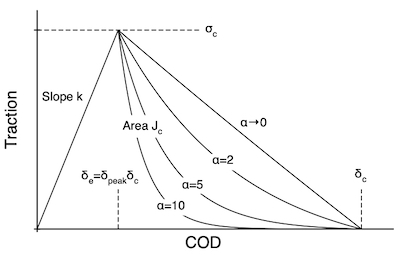Difference between revisions of "Coupled Traction Law"
| Line 2: | Line 2: | ||
== The Traction Law == | == The Traction Law == | ||
(This documentation is implementation of this law [[OSParticulas]] that is coming soon to [[NairnMPM]]. The current implementation in [[NairnMPM]] is different and should be used until updated to this new implementation). | (This documentation is implementation of this law [[OSParticulas]] that is coming soon to [[NairnMPM]]. The current implementation in [[NairnMPM]] is different and should not be used until updated to this new implementation). | ||
[[File:Exptraction.jpg|right]] | [[File:Exptraction.jpg|right]] | ||
This [[Traction Laws|traction law]] uses either the [[Triangular Traction Law|triangular cohesive law]] or the [[Exponential Traction Law|exponential cohesive law]] and | This [[Traction Laws|traction law]] uses either the [[Triangular Traction Law|triangular cohesive law]] or the [[Exponential Traction Law|exponential cohesive law]] but couples the normal and tangential displacements by defining an ''effective'' displacement. This implementation follows methods derived in a paper by Högberg <ref name="hogberg"/>. | ||
except that COD and traction are now effective terms that are related to normal and tangential components of traction and displacement: | except that COD and traction are now effective terms that are related to normal and tangential components of traction and displacement: | ||
| Line 46: | Line 46: | ||
== Traction Law Properties == | == Traction Law Properties == | ||
The properties you enter are the same as defined in | The properties you enter are the same as defined in | ||
Revision as of 11:47, 29 December 2020
The Traction Law
(This documentation is implementation of this law OSParticulas that is coming soon to NairnMPM. The current implementation in NairnMPM is different and should not be used until updated to this new implementation).
This traction law uses either the triangular cohesive law or the exponential cohesive law but couples the normal and tangential displacements by defining an effective displacement. This implementation follows methods derived in a paper by Högberg [1].
except that COD and traction are now effective terms that are related to normal and tangential components of traction and displacement:
[math]\displaystyle{ {\rm Traction} = T_{eff} \qquad{\rm where} \qquad T_{eff} = \sqrt{T_n^2+T_t^2} }[/math]
[math]\displaystyle{ {\rm cod} = \delta_{eff} \qquad{\rm where} \qquad \delta_{eff} = \sqrt{\delta_n^2+\delta_t^2} }[/math]
where Tn and Tt are the normal and tangential tractions and δn and δt are the normal and tangential CODs.
This law can be expressed using damage mechanics by defining an effective slope of
[math]\displaystyle{ k_{eff}=(1-D)k }[/math]
where k is the initial slope of the curve and D is a damage parameter. This effective slope describes a line from the origin to the point on the triangular curve corresponding to the maximum displacement seen on the current particle. The effective traction along that line is
[math]\displaystyle{ T_{eff}=k_{eff}\delta_{eff} }[/math]
The effective stiffness is found using
[math]\displaystyle{ (1-D)={\delta_{pk}(\delta_c-\delta_{max})\over\delta_{max}(\delta_c-\delta_{pk})} }[/math]
where δc is the critical effective cod and δmax is the maximum effective cod seen on the crack particle, except that it is initialized to the peak cod (δpk) at the start of the calculations. By this relation, D = 0 until the effective cod passes the peak cod. Thereafter, D increases from 0 at the peak to 1 at the critical cod. Once D is found, the normal and tangential tractions are:
[math]\displaystyle{ T_n = k_{eff}\delta_n \qquad {\rm and} \qquad T_t = k_{eff}\delta_t }[/math]
Together, these traction satisfy the effective traction - effective cod law given above. Note that during monotonic loading the traction will remain on the curve. If unloading occurs, however, the tractions follow a line back to the original from the maximum cod.
Failure
Under pure mode I or pure mode II, a coupled traction law and its failure are identical to a triangular traction law. Under mixed-mode conditions, however, the two laws differ and therefore provide two alternatives to modeling of mixed mode behavior. The use of effective terms in this coupled law is proposed to account for mixed mode effects with a single traction law. A potential concern, however, is that this law introduces history dependence in fracture experiments that may contradict observations in real materials.
Traction Law Properties
The properties you enter are the same as defined in
- ↑ Cite error: Invalid
<ref>tag; no text was provided for refs namedhogberg
